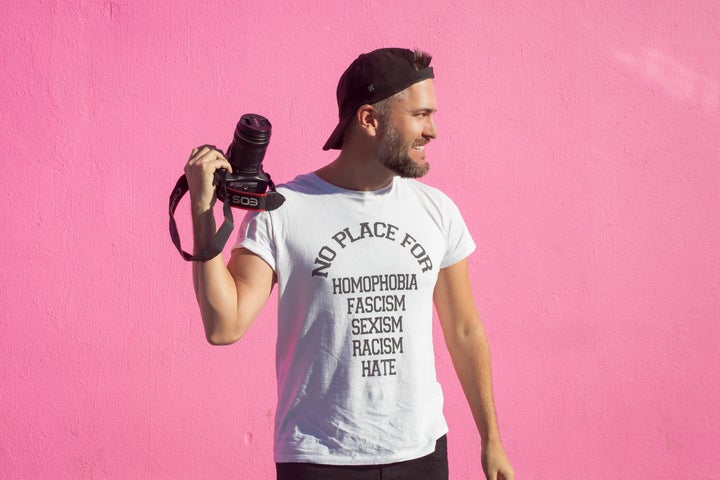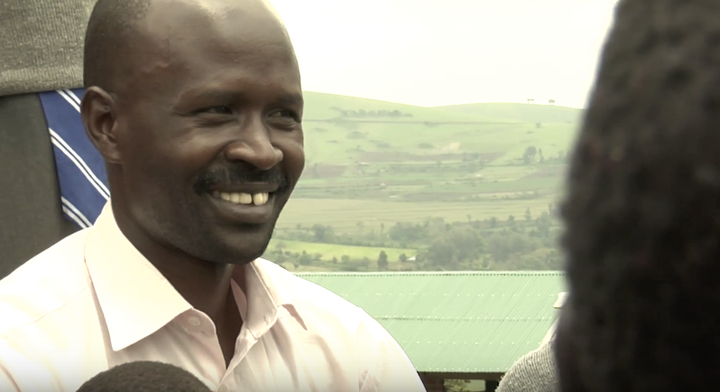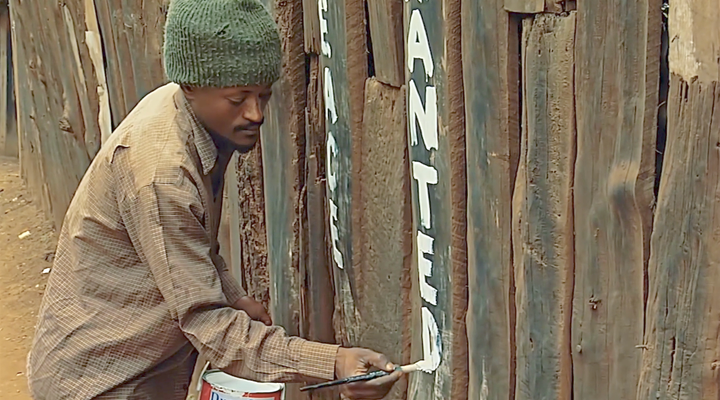
At first glance you can’t tell Tyler Batson, 34, has been through any hardship in his life. One would expect a man who lost everything in a house fire, his father to cancer, and survived abroad by working odd jobs would be hardened and cynical to life. Instead, Tyler managed to stay a kid at heart. I met him during a queer communal hiking trip in the Santa Monica mountains. He was frolicking about when I introduced myself. You can’t escape Tyler. He stands out. He’s young, but all his hair has greyed giving him the complexion of a silver fox. Every time he laughs, it sounds like a hearty roar, filling the air with all those good vibes you would associate with good company.
However, it is what Tyler said about peace that caught my attention. I can’t recall the last time I felt at peace with the state of the union. Neighbors have turned on each other over political candidates. A week doesn’t go by when we don’t hear about another tragedy. Our soon to be President-elect will take office hammering a misguided philosophy of law and order that sends chills down the spines of many people of color. Will things get worse? Can our democratic institutions handle a Trump presidency? I shudder at the thought of a civil war or a global war. How can we find peace once again when we can’t even look our neighbors in the eye? Apparently Tyler has some insight into the matter. Tyler spent almost a decade working on his first documentary, A Chance for Peace. During the 27,000 miles traveled throughout his journey, Tyler filmed in post-revolutionary Egypt, was in Turkey at the onset of the crisis in Syria, attended labor party protests in Thailand, and documented the stories of village artisans in India’s vibrant craft sector. But the majority of his time was spent traveling throughout Kenya, 8 months after a contested election launched the previously peaceful country into post-election violence that displaced 600,000 people, killing over 2,000. The lack of media coverage on such a tragic turn of events was Tyler's impetus for action. While the whole world seemed to turn away from the crisis, Tyler walked right into the epicenter with a cameraman and a question: "Is peace possible?"
You went above and beyond most people to complete this film, where did this drive come from?
I tell people this is more of a mission than a dream project. I could not have dreamed the places I’d go or the people I’d meet on this journey. I just sort of surrendered to what I felt was my purpose - because I simply could not escape this thing called “A Chance for Peace”! I tried to walk away from it, but I couldn’t genuinely move forward until I finished it. I did a lot of exploration to figure out where this desire to dialogue about peace came from, but gratefully I was able to work through it with my editor [laughs]. Once uncovered, the drive to finish it was non-negotiable. First, I had to accept that this wasn't going to be like other documentaries. Then, as I started picking apart my motivations, I realized I'd been preparing for this all my life. Growing up with a dying dad, I was always curious as to where my Dad’s cancer hurt. I never understood it. Subconsciously, I carried that desire to understand other people's pain into adulthood. It was through my own origin story that I could now begin to have a fuller understanding of peace.
Were there times you wanted to quit? Did you have any doubts?
Did I doubt that I could explain peace to the world by going into one of the biggest slums in Africa? Yeah. [Laughs]. I had my doubts. But they were delayed. I don't think I would've done this if I didn't believe that peace was possible. I had this determined faith, as I think many of us do, that peace is something we can - or at least should - all agree on. I found out really quick that it's not. And I'm not afraid to admit that I felt like I was in over my head. Nevertheless, I was there and I was confronted with the complexities of creating peace and I couldn't quit. I just couldn't.
But yes, there were many times in the last nine years I wanted to quit this role I had take on to "give voice to the voiceless," as I put it early on. But I learned that it wasn't so much that I wanted to walk away from the responsibility of “A Chance for Peace,” so much as that I was simply adamant about telling this story right. And I didn't know how yet. After filming in Kenya, I had to accept that I was more than a storyteller and that peace and violence and corruption are just as much my story as the Kenyan story. I had to ask myself, “How the hell am I supposed to do this? What qualifies me to even be here?” I questioned my motivations plenty of times. I had to ask myself if I was an ambassador of peace or just someone pretending to be.
How did you avoid the pitfalls concerning this area of the world, namely the white savior complex?
I volunteered in Kenya in the months leading up to the election. My host father, Emmanuel Leina, just so happened to be running for Member of Parliament, so I learned a lot about Kenyan politics, the needs of the people, and my role as a foreigner in their land. It was then that I realized that I was there to bear witness to the Kenyan experience, and that I would never truly understand what the Kenyan experience is truly like because I will never be Kenyan - but where I can align is along an understanding of what it’s like to be human. The post-election violence displaced 600,000 people and at least 2,000 were killed, many with live ammunition. Bodies were still being found as we were there filming. I realized that we were looking at was a very tragic response to the failure of the democratic process. It was a Molotov cocktail of fear, disenfranchisement, and corruption. Sound familiar? I had already realized and accepted that the “Kenyan response” to these pains was in fact a human response. Looking around at the US now - and throughout our history - we see parallels with Kenya that no one points out. So, no, I did not go to be some white savior, because I realized I couldn’t be. My country hasn’t figured out the answers yet. Our primary global strength, war, hasn’t yielded much but more war. So I was there to listen. My focus was on being the best messenger I could be to communicate their stories the right way.

What surprised you making this project?
One of the most jarring moments for me was when we were walking through Kibera slum, the epicenter of the post-election violence. I was looking down at the ground and saw a grenade of some kind just lying there in the dirt. It said "MADE IN U.S.A." This war that the media dismissed as just another case of African tribalism was our war. We were there. America was complicit in this violence. Fast forward to today, what really surprises me are the parallels to our society even though this happened over 8 years ago. The protests, the call for an end to the political establishment, and the fact that the Kenyan people were the ones paying the price - I looked at all of this and had to ask myself, How in the U.S. any different? Our country today is divided into tribes with our identity politics. Every human being is capable of violence and peace, good and evil - as human beings, none of us is above these things. So when I saw that grenade, it made my resolve to focus on peace even stronger.
What does surprise me, however, is how disoriented and confused Americans are now post-election. Kenyan’s snapped out of it pretty quickly. Despite the brutal violence they endured, they managed to come together and mend. America is in such a whirlwind of emotion that the country has no idea what’s going to happen next, or worse how to even talk about peace, let alone practice it.
How do we find peace?
We need to talk about peace, but we can’t talk about it if we aren’t engaging in it. There is a line in the film where I say, “Peace is not something you think or something you feel; it's something you do.” We all have a role to play, but we need to dismantle this idea that being right supersedes doing right.
We are having a crisis of culture. There are racial, economic, and xenophobic issues that are coming apart at the seams. What we see in “A Chance for Peace” is that all the men, women, and children we profiled instinctively knew how to engage in peace. As many of them put it, “We are just doing the best we can with what we have.”
At the time of Kenya’s post-election violence, the US media, and therefore the American public, didn't see a chance for peace. The media framed the Kenyan identity in the context of just a bunch of poverty-stricken people that now had to endure the hardships caused by their follies. So it comes as no shock to me that when the US media and the American public is confronted with the same issues on their own soil, the instinct is to respond just the same - spinning out with stories of violence, hate, distrust, and fear. We are stuck in a well-honed, misplaced sense of self-righteousness.
Take a look what the peacemakers in this film were able to achieve with so little. There was a man who built an academy from the ground up; a nurse who was able to provide free medical care for thousands of people; and a graffiti artist that with just a paintbrush and some white paint became a “Messenger of Peace.” Peace was a grassroots effort, and it can thrive anywhere. If we insisted on peace that same way many of us insist on war and attacking others, imagine where we’d be.

So to find peace I think we need to reject this idea that we can't create peace ourselves. Peace is a practice that starts with empathizing with each other, but first we have to take a cold hard look in the mirror and reject this idea that we are somehow better. These tribal tendencies aren’t limited to so-called “third-world” countries. We are a tribal species, but these memberships go by different names, be it Democrat or Republican or however you want to divide it. We’ve deluded ourselves into thinking we are above that because we are a “civilized” country. All we need to do it look around to see that we’re not above it. Lynching, for example - is that civilized? Police brutality? No. But people are waking up. The US is seeing it's own chance for peace right now, and I am not afraid. And I want to show people that they have nothing to be afraid of either. This is all part of an evolutionary process, and if we want to survive it, fear cannot direct our sails. We must actively choose peace, just as the Kenyans did. We must restore trust, view each other as a member of the human tribe, and build empathy. Everyday.
It sounds exhausting, but trust me once you get the hang of it you’ll be transformed.
In the movie you talked about looking for peace. Did you find peace?
[Laughs] I really love that question because I prepared myself for it! But strangely enough, I don’t really have a clear answer for you. I’ll explain. In Kenya and in my travels, yes, I found peace. I saw it in action and in practice. But I also saw the struggles that go along with it, I saw the setbacks and the heartaches right alongside the successes and the love - because that's what life is! To truly understand something we must also understand it's opposite. So when I say, "Yes, I found peace," I don't want people to just envision sunshine and roses. Its work. But its good work! As I said before, peace is something you have to actively do every single day. For most people it is an abstract thought or even a fantasy, but just ask them when the last time they participated in creating peace, then remind them that our understanding of peace is as deep as our practice of peace.
Sister Freda, our nurse in the film is a perfect example. Tens of thousands of people have come to her clinic in the nine years since the post-election violence. She wakes up every day knowing that even though she is resource deprived, she will find away to take care of the next person that walks through her door. But you don't have to be a Sister Freda. People come up to you everyday too. How you receive them is your opportunity to create a more peaceful world.

So are you saying that just as societies consciously mobilize for war, societies have to consciously mobilize for peace?
Exactly.
Now that your documentary is finished, are you done with the mission for peace?
Certainly not! I can’t walk away from it, especially now. But like all things, I’m ready for “A Chance for Peace” to evolve. Right now we are submitting to film festivals, seeking distribution, and hosting screenings. But I'd love to have a podcast or a web series that is informed by my work with "A Chance for Peace." And there are so many stories that didn't make it into the film that I've already started writing out. I'm a vehicle for peace, man! [Laughs]. And this train is looking for a few new cabooses! The tribe is definitely growing. It's a beautiful thing.
You can watch exclusive clips and Tyler’s vlogs on Youtube at www.youtube.com/achanceforpeace and learn more at www.achanceforpeace.com.
Instagram: www.instagram.com/achanceforpeace
YouTube: www.youtube.com/achanceforpeace
Twitter: www.twitter.com/achanceforpeace
